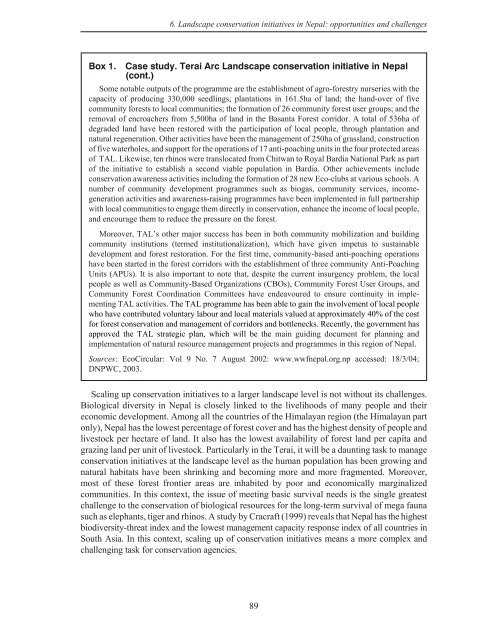The Protected Landscape Approach - Centre for Mediterranean ...
The Protected Landscape Approach - Centre for Mediterranean ...
The Protected Landscape Approach - Centre for Mediterranean ...
You also want an ePaper? Increase the reach of your titles
YUMPU automatically turns print PDFs into web optimized ePapers that Google loves.
6. <strong>Landscape</strong> conservation initiatives in Nepal: opportunities and challenges<br />
Box 1.<br />
Case study. Terai Arc <strong>Landscape</strong> conservation initiative in Nepal<br />
(cont.)<br />
Some notable outputs of the programme are the establishment of agro-<strong>for</strong>estry nurseries with the<br />
capacity of producing 330,000 seedlings; plantations in 161.5ha of land; the hand-over of five<br />
community <strong>for</strong>ests to local communities; the <strong>for</strong>mation of 26 community <strong>for</strong>est user groups; and the<br />
removal of encroachers from 5,500ha of land in the Basanta Forest corridor. A total of 536ha of<br />
degraded land have been restored with the participation of local people, through plantation and<br />
natural regeneration. Other activities have been the management of 250ha of grassland, construction<br />
of five waterholes, and support <strong>for</strong> the operations of 17 anti-poaching units in the four protected areas<br />
of TAL. Likewise, ten rhinos were translocated from Chitwan to Royal Bardia National Park as part<br />
of the initiative to establish a second viable population in Bardia. Other achievements include<br />
conservation awareness activities including the <strong>for</strong>mation of 28 new Eco-clubs at various schools. A<br />
number of community development programmes such as biogas, community services, incomegeneration<br />
activities and awareness-raising programmes have been implemented in full partnership<br />
with local communities to engage them directly in conservation, enhance the income of local people,<br />
and encourage them to reduce the pressure on the <strong>for</strong>est.<br />
Moreover, TAL’s other major success has been in both community mobilization and building<br />
community institutions (termed institutionalization), which have given impetus to sustainable<br />
development and <strong>for</strong>est restoration. For the first time, community-based anti-poaching operations<br />
have been started in the <strong>for</strong>est corridors with the establishment of three community Anti-Poaching<br />
Units (APUs). It is also important to note that, despite the current insurgency problem, the local<br />
people as well as Community-Based Organizations (CBOs), Community Forest User Groups, and<br />
Community Forest Coordination Committees have endeavoured to ensure continuity in imple -<br />
menting TAL activities. <strong>The</strong> TAL programme has been able to gain the involvement of local people<br />
who have contributed voluntary labour and local materials valued at approximately 40% of the cost<br />
<strong>for</strong> <strong>for</strong>est conservation and management of corridors and bottlenecks. Recently, the government has<br />
approved the TAL strategic plan, which will be the main guiding document <strong>for</strong> planning and<br />
implementation of natural resource management projects and programmes in this region of Nepal.<br />
Sources: EcoCircular: Vol 9 No. 7 August 2002: www.wwfnepal.org.np accessed: 18/3/04;<br />
DNPWC, 2003.<br />
Scaling up conservation initiatives to a larger landscape level is not without its challenges.<br />
Biological diversity in Nepal is closely linked to the livelihoods of many people and their<br />
economic development. Among all the countries of the Himalayan region (the Himalayan part<br />
only), Nepal has the lowest percentage of <strong>for</strong>est cover and has the highest density of people and<br />
livestock per hectare of land. It also has the lowest availability of <strong>for</strong>est land per capita and<br />
grazing land per unit of livestock. Particularly in the Terai, it will be a daunting task to manage<br />
conservation initiatives at the landscape level as the human population has been growing and<br />
natural habitats have been shrinking and becoming more and more fragmented. Moreover,<br />
most of these <strong>for</strong>est frontier areas are inhabited by poor and economically marginalized<br />
communities. In this context, the issue of meeting basic survival needs is the single greatest<br />
challenge to the conservation of biological resources <strong>for</strong> the long-term survival of mega fauna<br />
such as elephants, tiger and rhinos. A study by Cracraft (1999) reveals that Nepal has the highest<br />
biodiversity-threat index and the lowest management capacity response index of all countries in<br />
South Asia. In this context, scaling up of conservation initiatives means a more complex and<br />
challenging task <strong>for</strong> conservation agencies.<br />
89

















